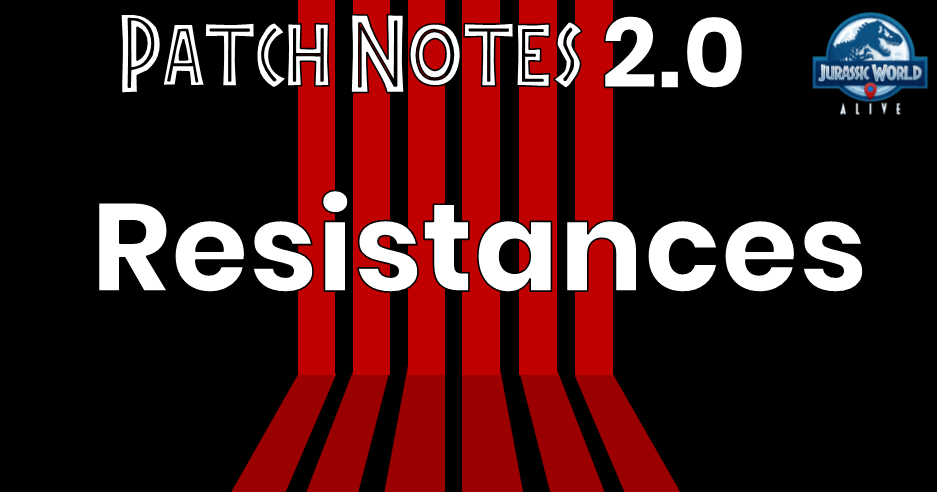Introduction
This is me right now.

Make no mistake, my friends, Resistances are the real star of 2.0. Before I get into how they work in the game, allow me a moment to explain why this mechanic is so much better than full or even partial immunities.
How They Can Save This Game
Imagine you have a scale and some random items of various sizes. These items represent the different stats that make up a creature. The weight of the items represents how powerful they are. Stats like HP and Attack are like tiny BBs. You can add or subtract individual BBs to tweak the weight of the entire creature. Speed would be like marbles. Still small enough to tweak the final weight, but 1 unit of speed is more impactful than 1 unit of HP or Attack. Still with me? Good.
Now if it were just these 3 stats, it would be fairly easy to build dinos of similar weights, or at least groups (tiers) of similar weights. But when you try to add in full immunity, it’s like adding a bowling ball to a creature. It’s a ridiculous amount of weight that has no granular elements to build up with. It’s either there or it isn’t. If you want to keep the balance with other creatures, you have to drastically change the other stats of either the immune creature or the other creatures. Partial immunities really helped by breaking the bowling ball up into, say, baseballs. You have some flexibility to add or take away the power in smaller increments, but each partial immunity still takes a lot of work to keep a balance.
Resistances take it a step further and break things down to a similar scale to HP/Attack/Speed. If a creature needs to be tweaked to keep the balance, they allow small changes to be made over time instead of big jarring shifts in the meta. They allow for more diversity in creature design and what roles they might play. Used properly, they have the power to heal the arena!
How They Work
OK, now let’s talk about how these things actually work. The patch notes actually spell it out fairly clearly, but I’ll give some examples that are a tad more concrete:
Taunt: This is the simplest one to explain. If creature A is Taunting and Creature B is 50% resistant to Taunts, there’s a 50% chance that Creature B will ignore the Taunt. If you don’t know what Taunt is yet, check out this article for an explanation. Don’t worry, I’ll wait for you to get back.
Swap Prevention (Pinning): This one is nearly as simple as Taunt. If Creature A uses a Pinning attack and Creature B has 50% resistance to Swap Prevention, then Creature B has a 50% chance of actually being pinned. This check is made at the time of the Pinning Attack. This means that if an attack would pin for 2 turns, Creature B has a 50% chance to be pinned for the full 2 turns and a 50% chance to be pinned for 0 turns. Now, if the Swap Prevention is coming from the No Escape ability, that check is made at the time of the EACH attempted swap. This means that if Creature B wasn’t able to swap one turn due to No Escape, it might still successfully swap the next turn.
Stun: Again, this is quite similar to the previous examples, but now we have 2 RNG mechanics interacting with one another. If Creature A uses an attack with 75% chance to stun and Creature B has a 50% resistance to stunning, that means the overall chance of a stun happening is 37.5%. You multiply the chance to stun (0.75) by the chance to resist the stun (0.5) to get the effective stun chance. This is important since some stuns have different chances.
Distraction: When looking at a single instance of Distraction, this is easy. If Creature A uses a 50% Distracting move against Creature B with 90% resistance to Distraction, the end result is 5% Distraction. But when you start stacking Distractions it gets a bit more complicated. Distraction effects are additive, but the resistance to them is multiplicative. It’s also important to note that stacked Distraction effects are not capped at 100%. So to figure out the total Distraction, you add up all the effects and then apply the resistance. For example, if Creature B got hit with two 75% Distractions, the end result would be (0.75+0.75)(1-0.9)=0.15. That’s 15% Distraction.
Deceleration: This one works exactly like Distraction. If Creature A uses a 50% Decelerating move against Creature B with 90% resistance to Deceleration, the end result is 5% Deceleration. For example, if Creature B got hit with two 50% Decelerations, the end result would be (0.5+0.5)(1-0.9)=0.10. That’s 10% Deceleration.
Damage over Time (Bleed): This is another simple one. If Creature A uses Lethal Would (33.34% over 3 turns) on Creature B with 50% resistance to DoT, Creature B will be taking 16.67% each turn for 3 turns. Each instance of DoT is tracked separately.
Rend: Even simpler than DoT since there’s no T involved. If Creature A uses Rending Takedown (60% Rend) on Creature B with 50% resistance to Rend, the end result is 30% Rend.
The remaining two Resistances (Critical Decrease and Vulnerability) I’m going to need a little more time to test. I have a pretty good idea of how they will function, but I don’t want to give you the wrong info here. Don’t worry, once I am 100% sure how they work, I’ll add it here.
More 2.0 Goodies!
Even though Resistances are the 2.0 feature I'm most excited about, there are still tons of other things to digest. Don't forget to check out the rest of our Patch 2.0 articles!
When you can't contain your excitement any longer, be sure to visit our Discord to share in the hype!




